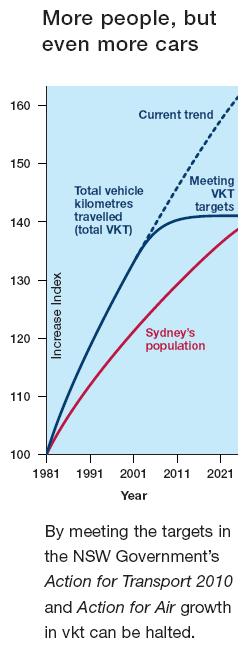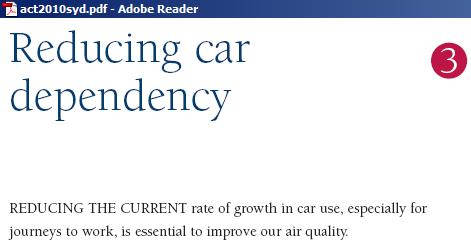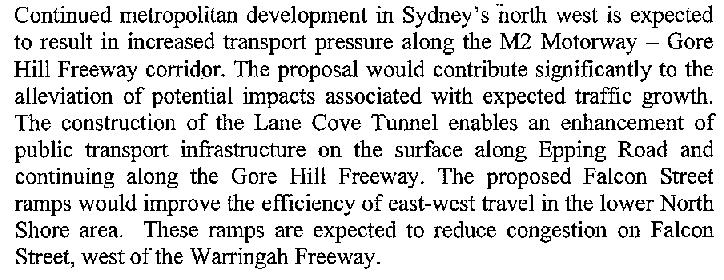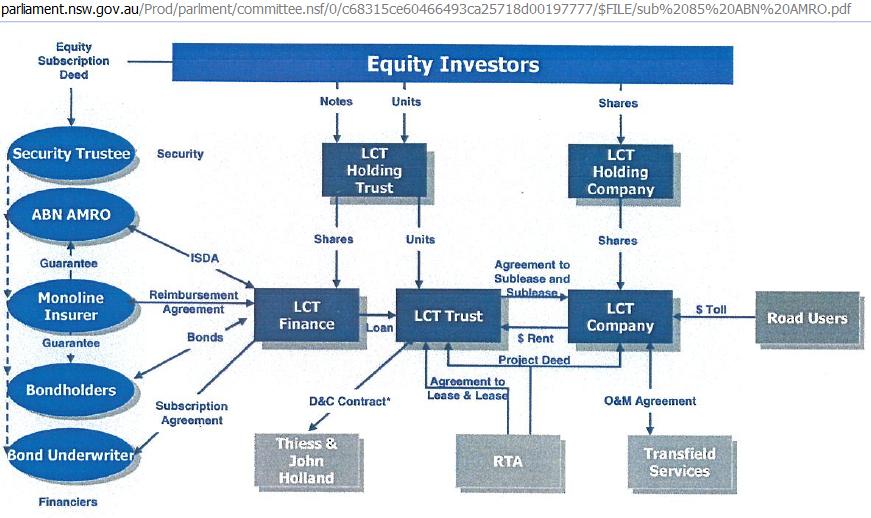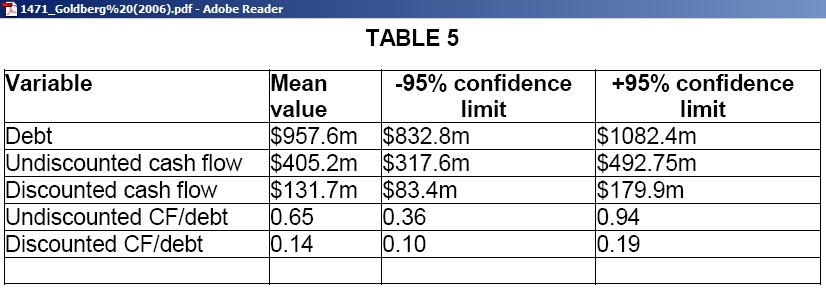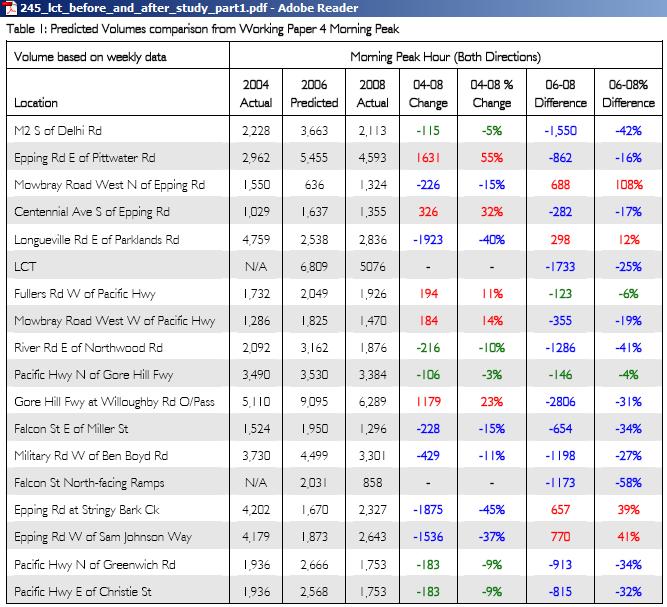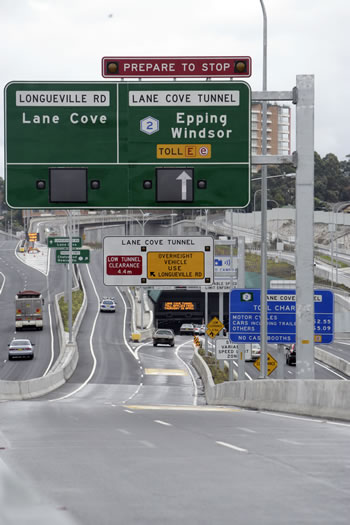 Summary: Peak oil impacts in various ways on toll-ways financed by debt. As mentioned in a previous post
Summary: Peak oil impacts in various ways on toll-ways financed by debt. As mentioned in a previous post
peak oil = peak credit
http://www.crudeoilpeak.com/?p=430
This means that it has become harder to re-finance or roll-over debt. Secondly, higher fuel prices reduce the paying capacity of motorists for tolls. Thirdly, a recession means fewer trips to jobs. Therefore, peak oil hits those toll-ways first which have high debt and where revenue is based on too optimistic traffic projections. These factors can be considered as “pre-conditions”. Driver boycotts and community backlash over local environmental and traffic management issues can complicate things further.
During the Cross City tunnel inquiry by a Select Committee of the NSW Parliament in 2005 which was extended to cover the Lane Cove tunnel as well, a researcher from the Sydney Uni, John L. Goldberg, predicted insolvency for the Lane Cove tunnel due to very low cash to debt ratios.
He found that traffic projections were a work-back based on assumed dividends and internal rates of return and NOT a forecast using transport and land use parameters. And, we might add, definitely not considering oil supply limitations.
Now that the Lane Cove Tunnel went into receivership, it is clear that the moment of the truth for this flawed approach – which was designed in an era of $20 oil – has apparently been brought forward by peak oil and higher fuel prices.
This article is about whether there is any reference to peak oil or limited oil and energy supplies in planning documents related to the Lane Cove Tunnel. There is none.
<<Map of the Sydney motorway orbital.
During the whole planning process it was sufficient to justify the tunnel as a “missing link” in the Sydney orbital.
Tolls were obviously set too low.
The whole concept of long-distance commuting on toll-ways has come to an end.
And with it the unsustainable Metropolitan Strategy of putting another million population into Sydney.
(1) Early 1990s: First tunnel proposals after opening of Gore Hill Freeway
(2) 1997 M2-Epping Rd Task Force
(3) 1998 Action for Transport 2010
Surprisingly, this report calls for “reducing car dependency” and “halting VKT growth”. Why then a new road tunnel?
REDUCING THE CURRENT rate of growth in car use, especially for journeys to work, is essential to improve our air quality.
• Improve current bus and train services.
• Build an extensive integrated public transport system including new railways and rapid bus transitways.
• Construct a network of cycleways.
• Ensure better land use and transport planning.
• Encourage innovative transport and working arrangements.
http://pandora.nla.gov.au/pan/38334/20040302-0000/www.transport.nsw.gov.au/pubs_legal/act2010syd.pdf
| July 1999: Oil geologist Colin Campbell warns the House of Commons about peak oil: http://www.oilcrisis.com/Campbell/commons.htm With so many UK born professionals in Australia why was this missed? |
(4) Dec 1999 Lane Cove Tunnel Overview Report
(5) October 2001 EIS by RTA. The executive summary of this EIS (available in the RTA submission 114 to the Cross City Tunnel Inquiry) states about the need of the tunnel:
The benefit cost ratio (BCR) is given as 4.7
March 2002: Woodside Petroleum’s John Akehurst warns of declining Australian oil production. From B.Robinson, ASPO http://www.stcwa.org.au/papers/data/oil_vuln.doc
(6) July 2002 RTA Preferred Activity report
http://www.rta.nsw.gov.au/constructionmaintenance/downloads/lanecovetunnel_brochure.pdf
(7) Nov 2002 Director General’s report refers to the Action for Transport 2010 Report
http://www.planning.nsw.gov.au/assessingdev/pdf/consents02/lanecovetunnel-FinalDGReport.pdf
(8) Dec 2002 Project Approval by Planning Minister
(9) Dec 2003 Contract signed between RTA and Lane Cove Tunnel Company
(10) June 2004 work starts
(11) July 2004 RTA Summary of contracts
http://msmwww.treasury.nsw.gov.au/__data/assets/pdf_file/0006/3111/lane_cov.pdf
(12) Nov 2005 Joint Select Committee on Xcity and Lane Cove tunnel
http://www.parliament.nsw.gov.au/crosscitytunnel
(13) Dec 2005 Premier’s Department
Review of Future Provision of Motorways
Selected extracts which typify the thinking and methodology of the NSW Government:
“Recommendation: Because revenue from future motorways in Sydney will reflect network wide patronage and, as a consequence, the risk linked to traffic volumes is likely to be less, PPPs used to provide future Sydney motorways should focus on the whole-of-life and innovation benefits of PPPs, and not as heavily on the transfer of financial risk.”
“For example, construction costs of the CCT, LCT and the M7 exceed $3 billion. If financed by State debt annual interest costs would be around $200 million, excluding any principal repayments. Funding to maintain and operate the roads is estimated to require around $120 million per annum. So an annual cost of $320 million (plus principal repayments) is shifted from the State budget to road users“
“The requirement to write a contract to cover a period up to 30 years ensures a greater level of due diligence in relation to the quantification and allocation of risk.
The term and the complexity of the contract arrangement leads to greater scrutiny from stakeholders such as Treasury and the various bankers and financiers, in addition to the normal agency and contractor relationship.“
“But the principal financial risk assumed by a motorway PFP is harder to assess and therefore to price, the risk of mismatch between traffic volumes and predictions and therefore between estimated and actual toll revenues. Government can take this type of risk – for example, the New South Wales Government took the risk on traffic volumes when the Sydney Harbour Bridge opened. However particularly in the early stages of the motorway program the scale of this risk when set against the RTA’s usual allocations of general government funds was considered inappropriate for Government to take.”
“The cost of money for a PFP-financed motorway project reflects the project risk where there is no government borrowing or guarantee. In motorways in New South Wales, government generally has chosen for good reason to transfer traffic risk to PFPs. The return to this risk is higher than the interest rate on AAA debt.“
„At key milestones in the life of a project the Cabinet – through the Budget Committee of Cabinet (BCC) and the Infrastructure and Planning Committee of Cabinet (IPCC) – reviews and makes decisions at various points through most of the above phases. The IPCC addresses broad land use and regional strategic planning, reviews the State Infrastructure Strategy and major infrastructure projects. The BCC determines all budget issues and formally approves projects and their funding arrangements. In this regard, the CCT proposal which was set out in Action for Transport 2010 as part of the Government strategic road upgrade plans was reviewed and approved at various stages by Treasury and the BCC before proceeding.“
http://www.nsw.ipaa.org.au/00_pdfs/Motorways2005.pdf
The word „oil“ or „fuel“ cannot be found in this document. Neither any resource analysis in the list of Government tasks. This should come right at the beginning, together with “strategy issues”
(14) Dec 2005 Hearing Joint Select Committee (9/12/2005)
In contrast to the polished statements from the Premier’s department Dr. Goldberg explains to the Committee (extract from Hansard):
CHAIR: The chart on the screen is titled “Illustration of the work back method of deriving
traffic volumes”.
Dr GOLDBERG: You find as I show you that the CCT financial model fits this perfectly.
You start with a series of equity dividends, giving a certain internal rate of return on investment to the tunnel. There are a couple of superannuation funds unfortunately in this, and I will tell you why I say “unfortunately” in a moment. They manipulated the net profit after tax and the dividends to get a financial balance, and then they work back to the toll revenue. They take the expenses away from the toll revenue. They plug in various numbers to get the net profit after tax and finally out comes an equation for the traffic volumes. ……
What is more, this will happen on the Lane Cove tunnel as well because in the base case financial model for the CCT the RTA mentions that the preliminary model was done the same way.
So his prediction has materialized, 4 years later
Tunnels finances ‘engineered’ January 22, 2010
http://www.smh.com.au/national/tunnels-nances-engineered-20100121-moak.html
(15) May 2006 ABN AMRO submission Inquiry Cross City Tunnel
This gives an overview of the project’s corporate, contractual and financial structure (p 2)
 July 2006 Iranian oil expert Dr. Bakhtiari presents his WOCAP oil production model in a hearing of the Senate Inquiry on future oil supplies in the Jubilee room of the NSW Parliament House, right in the centre of Governmentbut despite invitations NSW decision makers are absent from the proceedings. The late Bakhtiari, one of only 2 OPEC whistleblowers, describes transition phase T1 between growing and declining oil production.http://www.aph.gov.au/hansard/senate/commttee/S9515.pdf July 2006 Iranian oil expert Dr. Bakhtiari presents his WOCAP oil production model in a hearing of the Senate Inquiry on future oil supplies in the Jubilee room of the NSW Parliament House, right in the centre of Governmentbut despite invitations NSW decision makers are absent from the proceedings. The late Bakhtiari, one of only 2 OPEC whistleblowers, describes transition phase T1 between growing and declining oil production.http://www.aph.gov.au/hansard/senate/commttee/S9515.pdf |
(16) August 2006 Third report Joint Select Committee on the Cross City Tunnel
Appendix 9 Dissenting Report mentioning “rising cost of petrol, dwindling oil supplies and the global warming contribution from vehicle emissions” based on my submission
(17) September 2006 THE FATAL FLAW IN THE FINANCING OF PRIVATE ROAD INFRASTRUCTURE IN AUSTRALIA John L Goldberg
http://www.patrec.org/web_docs/atrf/papers/2006/1471_Goldberg%20(2006).pdf
This was a reviewed contribution to the Australasian Transport Research Forum (ATRF) http://www.patrec.org/atrf.aspx
Chapter 6 describes the financial status of the Lane Cove Tunnel in terms of equity/debt arrangements:
 Goldberg writes: “It will be noted from the table below that the undiscounted cash flow to debt ratio has only a 5% chance of equalling a value of 0.94. .But in any case, the discounted value of the ratio is nearly five times less likely to reach this value. What this result means is that irrespective of the attempt at creative accounting of the cash flows, involving the occasional injection of very large amounts of capital into the cash flow and the large overstatement of available reserves, the Lane Cove Tunnel project is potentially insolvent”
Goldberg writes: “It will be noted from the table below that the undiscounted cash flow to debt ratio has only a 5% chance of equalling a value of 0.94. .But in any case, the discounted value of the ratio is nearly five times less likely to reach this value. What this result means is that irrespective of the attempt at creative accounting of the cash flows, involving the occasional injection of very large amounts of capital into the cash flow and the large overstatement of available reserves, the Lane Cove Tunnel project is potentially insolvent”
Table 5: Cash flow/debt ratios – which should be greater than 1
Goldberg calculates the lane loadings from the financial model (toll revenue) and puts it in figure 4, noting that service levels on such highly used lanes would reach the limits of stable flows.
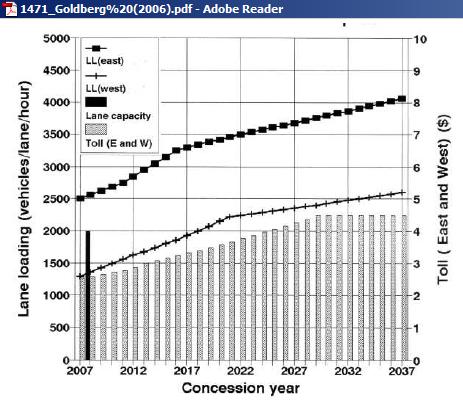 Figure 4 shows the fantasy growth of traffic assumed in the Lane Cove Tunnel
Figure 4 shows the fantasy growth of traffic assumed in the Lane Cove Tunnel
Most of these lane loadings are physically impossible and/or are unacceptable for a tollway.
This traffic will never materialize anyway because the carbon free primary energy for cars will simply not be there. We’ll see the end of our car culture in this decade.
http://www.crudeoilpeak.com/pdfs/17
However, Goldberg does not seem to be aware of peak oil so his criticism is based solely on the financing and traffic projections.
(18) Dec 2006 RTA Surface traffic modifications
“The need for the Approved Project is demonstrated by the current performance of Epping Road and the Gore Hill Freeway, which experience significant congestion during both the morning and evening peaks. The Approved Project provides transport efficiencies including free flowing traffic and more efficient fuel usage”
“The Lane Cove Tunnel EIS predicted that over 100,000 vehicles per day would be transferred to the Tunnel from surface streets and that surface traffic on Epping and Longueville Roads would be reduced by up to 60%. Anticipated travel time savings of 6 to 14 minutes in the morning peak and 15 to 22 minutes in the evening peak were also predicted in the EIS”
http://majorprojects.planning.nsw.gov.au/files/10759/Environmental%20Assessment.pdf
(19) March 2007 Opening of tunnel
(20) Oct 2009 ARUP’s Lane Cove Tunnel Post Opening Traffic Evaluation
http://www.buildingsydneymotorways.com.au/attachments/245_lct_before_and_after_study_part1.pdf
(21) Jan 2010 Lane Cove Tunnel Operators hits the wall
“The owner and operator of Sydney’s Lane Cove Tunnel has been placed in receivership, after creditors finally refused to grant another extension over the repayment of $1.14 billion of debt”
http://www.smh.com.au/business/lane-cove-tunnel-operator-hits-the-wall-20100120-mkca.html
MATT O’SULLIVAN continues: “The receivership is a further embarrassment for the NSW Government, which has been dogged by other failed infrastructure projects such as the Cross City Tunnel.”
Indeed. I had written this submission:
8/1/2006
How Cross City Tunnel Planners ignored peak oil
http://www.crudeoilpeak.com/?p=219
„Large pension funds and toll road operator Transurban, which itself has been the subject of advances from Canadian pension funds, have been considered to be the most likely buyers of the tunnel.”
That will be a tough nut. There is now the competing rail tunnel Epping – Chatswood in place so if we come into an oil supply emergency in an oil vulnerable country:
31/7/2009
Australia in last quarter of its oil age
http://www.crudeoilpeak.com/?p=182
with no Strategic Oil Reserve and a complacent Government:
15/1/2010
Report Card 2009 (part 1) – Energy Policy – Has the Federal Government prepared for declining oil production?
http://www.crudeoilpeak.com/?p=948
the quickest way to connect the North West of Sydney by mass public transport is a rail line on the M7/Windsor Rd – M2 to the Epping station (Transperth model). So there is really no function for the Lane Cove Tunnel in that situation.
I predict that when there are diesel shortages, all buses on the M2 from the West will end at Epping station because there is enough capacity in the Epping-Chatswood rail tunnel towards the North Shore and CBD. Dito for electric trolley buses because time and cost of installation will matter, nothing else.
‘Operationally the tunnel and Military Road E-Ramp are performing well with patronage having increased by almost 9 per cent over the past 12 months,’’ he said.
That will not last long.
18/1/2010
What is the world prepared to pay for crude oil above 73 mb/d?
http://www.crudeoilpeak.com/?p=976
Australia’s mineral export performance is closely linked with the destinies of China:
9/11/2009
World needs to save at least 3 mb/d by 2020 for China to grow. Any volunteers?
http://www.crudeoilpeak.com/?p=525
MATT O’SULLIVAN “Another potential acquirer could be Queensland Investment Corp, which bought a 25 per cent indirect stake in the M7 from MIG earlier this year.”
Oops. QIC is already bogged down with the BrisCon share disaster 2008/09
http://www.investsmart.com.au/news/news.asp?DocID=SMH090910B77S11IOSOL&Action=Display&s_cid=newsletter:is:1043
They ignored these terms of reference which I submitted in the public consultation process:
29/1/2008
Terms of Reference for Urban Transport under Severe Carbon Constraints
http://www.crudeoilpeak.com/?p=425
(22) The outlook for tollways
MIG spin-off takes heavy toll
January 26, 2010
Investor distaste for Macquarie Infrastructure Group’s debt-burdened spin off, Macquarie Atlas Roads, has been made clear after the market valued it at large discount to its directors’ valuation.
Macquarie Atlas Roads’ investments include the M6 in Britain, the APRR in France, the Chicago Skyway, the Indiana Toll Road and the South Bay Expressway in San Diego.
MIG’s chairman, Mark Johnston, said on Friday that Macquarie Atlas Roads was unlikely to pay distributions to shareholders for another four to five years because of insufficient cashflows.
http://www.smh.com.au/business/mig-spinoff-takes-heavy-toll-20100125-muji.html
(23) Are the lessons learnt? And which lessons?
TONY SHEPHERD: This is one project out of 10 road projects that I’m aware of that’s had some problems; most of the rest of them did extremely well. So I don’t think it kills the model, I think the model will be modified.
http://www.abc.net.au/7.30/content/2010/s2798318.htm
Tony Shepherd is the Chairman of ConnectEast, the operator of EastLink, originally Mitcham Freeway. I warned in 2004 this project would become a victim of Howard’s flawed energy white paper:http://www.crudeoilpeak.com/?p=208
ConnectEast books annual loss of $531.5m
August 24, 2009
Toll road operator ConnectEast Group has reported an annual net loss of $531.58 million and announced another equity raising, this time for up to $421 million.
Its 2008/09 result included a writedown on the EastLink toll road concession of $400 million – to about $2.9 billion – after an independent review of traffic.
ConnectEast is actively working to grow traffic and revenue on EastLink through a range of measures such as marketing and the installation of 49 new directional signs pointing to EastLink on Stud Road, Springvale Road and the Nepean Highway.
Sounds familiar. Lessons not learnt.
Conclusion: Investing in another road tunnel project in Sydney will be Russian roulette. For example, the proposed F3 to M2 tunnel, one of the items on RTA’s wishlist, another “missing link”, has a benefit cost ratio barely above 1. Details are here:
13/4/2007 The End of Freeways – the tipping points of Peak Oil and Global Warming
http://www.crudeoilpeak.com/?p=48
Superannuation funds should be careful. The fee bonanza continues. $80 million (= 4 kms of surface metro) were spent for splitting MIG into Atlas Roads and Intoll
The toll-way debacle also means that the whole strategy of long distance commuting by car is now stuck in a dead end. The tolls are actually too low to cover the cost. Therefore, the city structure = spatial distribution of land uses and their densities is uneconomic. In the next oil price shock things will get worse. Desperate attempts to increase densities by whacking in high rise flats will fail. The more people there are, the more food-, water- and petrol shortages there will be.
In fact, the whole perpetual growth plan of the Metropolitan Strategy must be abandoned and immigration reduced immediately. All efforts should focus how to rescue the existing system, not to grow what is already unsustainable now.
My 8 recommendations are here:
7/10/2009 Too late for Sydney Metro Tunnels http://www.crudeoilpeak.com/?p=290
Emergency surface rail solutions for the North-West:
Epping-Quakers Hill on M2 and M7
Norwest Business Park – Pennant Hills on Castle Hill Rd
CBD – West Ryde on Victoria Rd.
If decision makers could only understand we have just 5-10 years time to replace long distance commuting by car for the whole metropolitan area of Sydney.
A timetable is here:
http://www.crudeoilpeak.com/pdfs/1
Download this article as PDF file: [download id=”18″]

